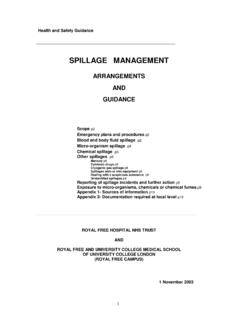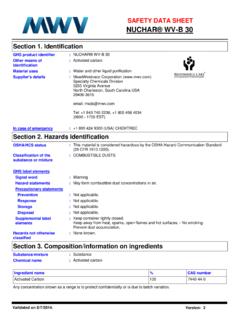Transcription of Executive
1 Health and Safety Executive personal protective equipment em6 (including RPE). asbestos essentials equipment and method sheet Non-licensed tasks What this sheet covers This information will help This sheet describes what personal protective equipment (PPE). employers and the self- you need. employed to comply with the Control of Asbestos It also describes respiratory protective equipment (RPE). Regulations 2012. PPE and RPE are your last lines of defence against asbestos fibres. It is also useful for trade union Follow the methods in the task guidance sheets to avoid fibres and employee safety representatives.
2 Being released into the air. Only carry out work if you are properly trained and have the Overalls right equipment . disposable overalls Type 5 (BS EN ISO 13982-1+A1) are suitable. Remember: You may need waterproof overalls for outdoor work. Asbestos fibres can cause Wear one size too big to help to prevent ripping at the seams. fatal lung disease and lung If the cuffs are loose, seal them with tape. cancer. Avoid wearing a long-sleeved shirt these are difficult to cover Check what you're working properly. on before you start. Wear the overall legs over footwear. Tucking them in lets dust into Read the safety checklist footwear.
3 And sheet a0. You must be trained to work Wear the hood over RPE straps. safely with asbestos Dispose of used overalls as asbestos waste. materials. Gloves Caution If you wear protective gloves, use single-use disposable gloves. If Never use laced boots; you must use latex gloves, use only low-protein powder-free' gloves. these are very difficult to Dispose of used gloves as asbestos waste. clean properly. Never take used overalls home. Footwear Never leave the respirator Boots are preferable to disposable overshoes which can cause a lying around where it can slipping risk. collect dust.
4 Choose boots without laces as these are easier to clean. Never dangle the respirator around your neck. Make sure the correct filter is fitted. 1 of 3 pages em6 personal protective equipment (including RPE) Health and Safety Executive Respiratory protective equipment Use suitable RPE with a UK-assigned protection factor (APF) of 20. or more. Suitable types of RPE: disposable respirator to standards EN 149 (type FFP3) or EN 1827 (type FMP3);. A dust mask' doubled up for half-mask respirator (to standard EN 140) with P3 filter;. more protection is useless. You semi- disposable respirator (to EN 405) with P3 filter.
5 Need a respirator This equipment should be suitable for most short-duration non- licensed work. Workers should select a make and size that fits them. This equipment is not suitable for people with beards or stubble . hooded respirators are required for these situations. The equipment is also unsuitable for long periods of continuous use; you need power-assisted equipment for such situations. Planning and preparation disposable RPE worn correctly Plan for and practise emergency procedures such as failure or damage to RPE. Workers need to be fit tested to make sure that the RPE fits them properly.
6 Arrange fit testing and training on use and inspection of RPE. before the work starts. Ask the supplier for help or contact for details of accredited fit test providers. See More help on sheet a0. disposable RPE worn correctly Workers must be medically fit to wear RPE seek medical advice if you are not sure. Training Make sure that RPE users know: how to check their equipment is working properly before they put it on;. how to check that it fits;. how to identify and replace worn or defective parts;. disposable RPE worn incorrectly about the limitations of the RPE they are using. Instruct users to throw away disposable RPE/PPE as asbestos waste after one use.
7 Tell workers to stop work and leave the area if they think their RPE. is not working properly. Using RPE. All types of RPE restrict what the wearer can do. It is uncomfortable to wear for long periods, but it is important that you protect yourself. RPE has to be worn all the time and until the worker is away from For some tasks, non- disposable the contaminated air. RPE is needed 2 of 3 pages em6 personal protective equipment (including RPE) Health and Safety Executive Put on and wear the respirator in accordance with your training and the manufacturer's instructions. Carry out a fit check in accordance with your training and the manufacturer's instructions.
8 If the worker wears spectacles, they should ensure they do not create a gap between the mask and face. Put the overall hood over the straps. At the end of the shift, take off RPE last and, if it is disposable , put it in the asbestos waste. For non- disposable RPE, clean after use and store in a safe place away from contamination. With half-mask respirators, change filters regularly your supplier may be able to advise you how often. Dispose of used filters as asbestos waste. Maintenance of non- disposable equipment Keep RPE clean and in good working order follow the manufacturer's instructions.
9 Inspect and check RPE for damage every time. Carry out thorough checks monthly (or every three months if used infrequently). Inspect all parts including valves and seals. Replace the respirator as appropriate. For information about health and safety, or to report inconsistencies or inaccuracies in this guidance, visit You can view HSE guidance online and order priced publications from the website. HSE priced publications are also available from bookshops. This guidance is issued by the Health and Safety Executive . Following the guidance is not compulsory, unless specifically stated, and you are free to take other action.
10 But if you do follow the guidance you will normally be doing enough to comply with the law. Health and safety inspectors seek to secure compliance with the law and may refer to this guidance. This document is available at: Crown copyright If you wish to reuse this information visit for details. First published as part of Asbestos essentials task manual 2001. Published by the Health and Safety Executive 09/17 3 of 3 pages
















